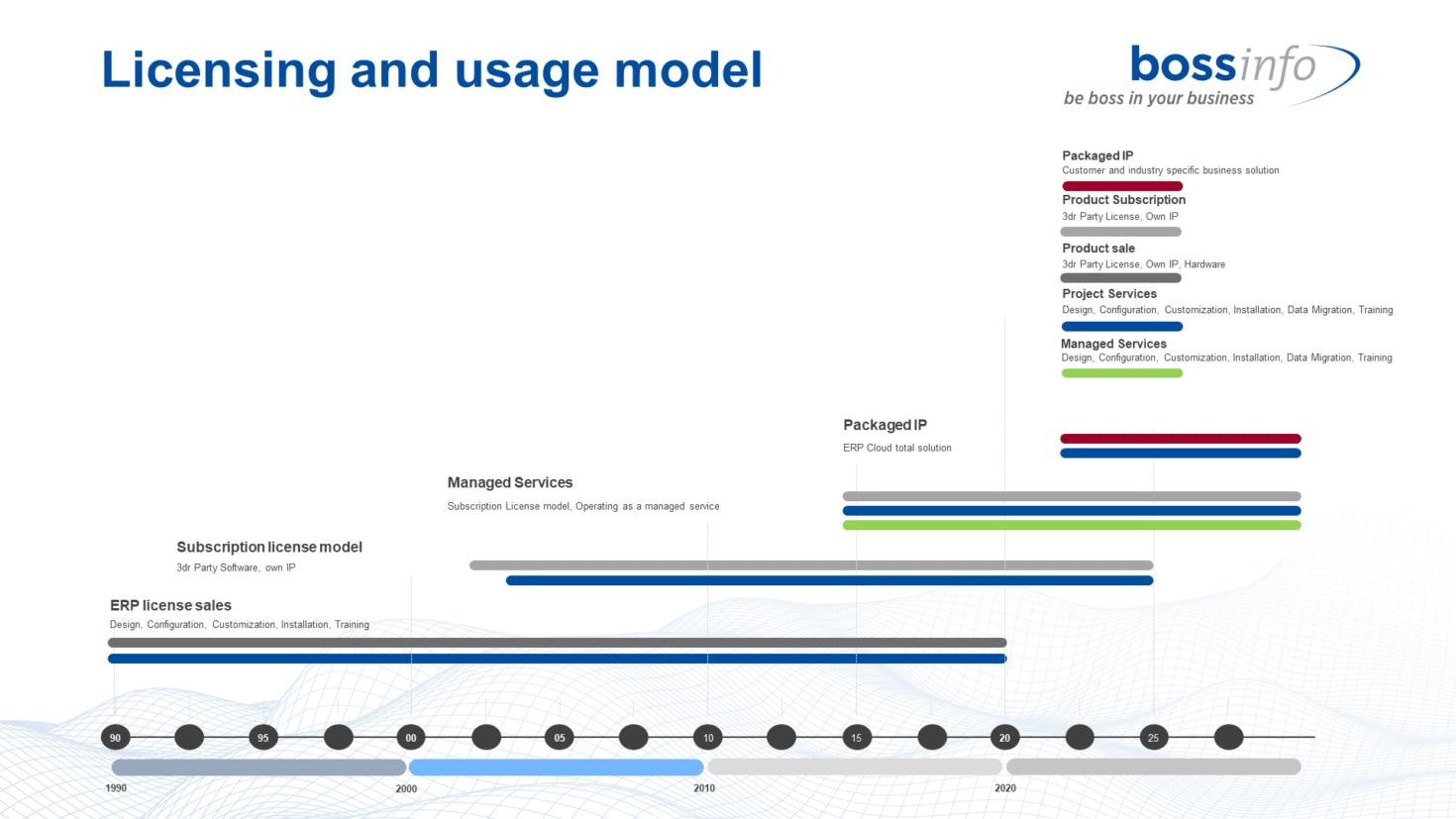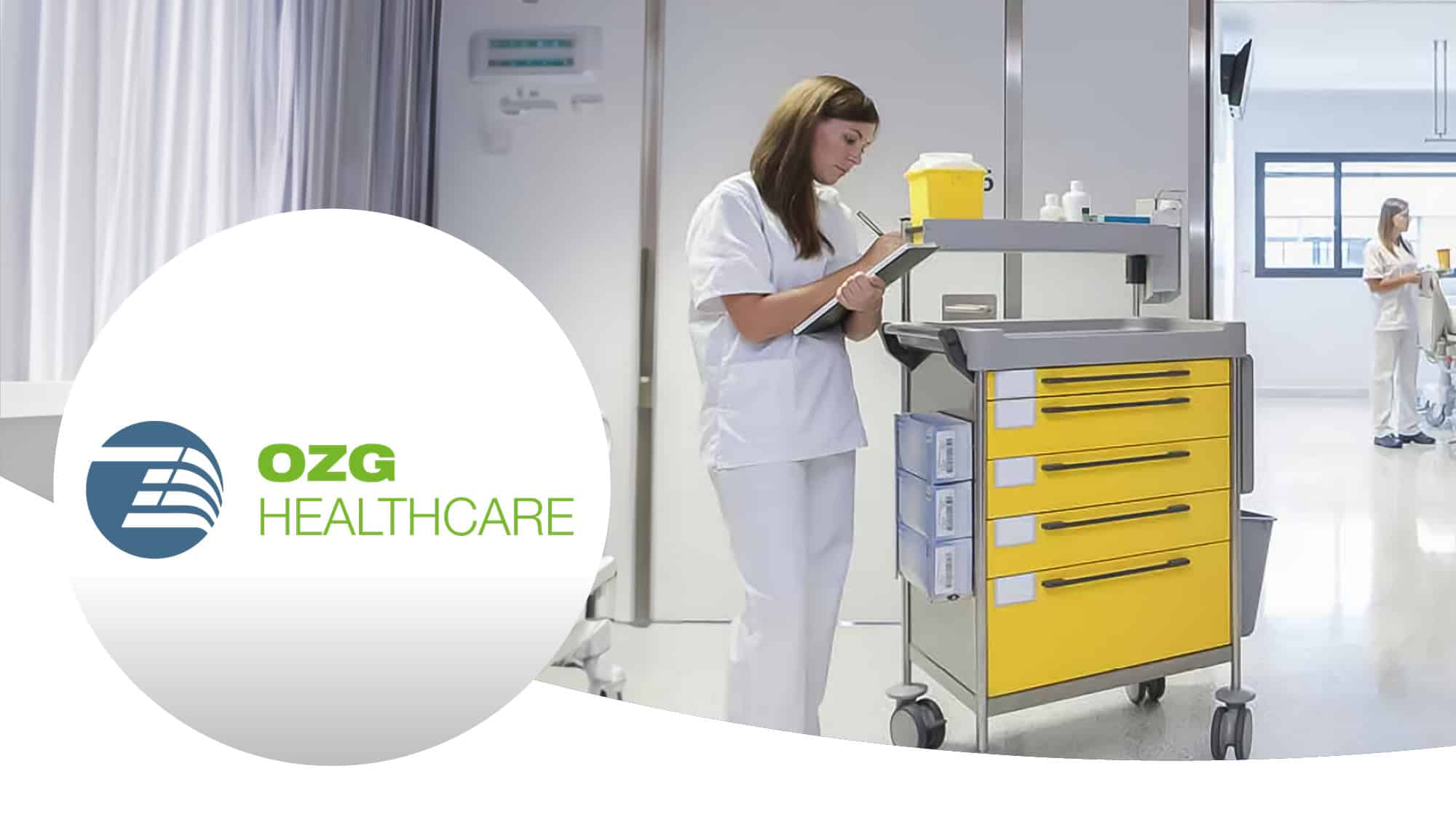The history of business software summarized
WEF forecasts regarding business software
In 2016, the World Economic Forum predicted that all products will become services by 2030. I was pleasantly surprised that this future assumption has already become reality for so many products and especially for ERP. We had worked hard for this at Boss Info and now offer ERP solutions including add-ons from a single source, our Boss Info Stack.
Forecast 1990: ERP development
Linking separate applications from different technical areas to create a commercial solution. (Manufacturing Resource Planning, Sales, Procurement, Finance and Human Resources).
Forecast 2020: ERP development
A holistic, seamless, paperless, location-independent, proven business solution which is available 24/7, with maximum cyber security and operational reliability, and complies with all the latest laws and regulations, according to the concepts of digital twins in real time and visualization with track and trace.
What does an ERP system do?
Sometimes referred to as “the central nervous system of a company”, an ERP software system provides automation, integration and management of the core processes that are essential for efficient operation of a business on a day-to-day basis. Most, if not all, of an organization’s data and documents should be stored in the ERP system to provide a single source of information throughout the organization. The focus is on the efficient operational value creation process and the management of business and operational processes.
This business task of planning, controlling and managing personnel, resources, capital, equipment and materials as required has not changed. However, there are also requirements to integrate customers and suppliers into all ERP processes using ICT, as well as the increasing influence of regulators (legislators, financial markets, etc.), which are having an increasingly rapid influence on the design of processes. This requires ERP solutions, which are constantly updated to reflect the state of the art – like a GPS without updated maps, an ERP which hasn’t been updated won’t do its job. All ERP manufacturers responded to this call for updatable ERP systems in different ways.
What is an ERP? (DE)
Change in licensing and usage model?
Covid-19 had a huge impact on on-site work and encouraged the shift online, and the model of delivering services has changed greatly. Cloud solutions became popular and are in demand. The ERP change was reflected in the licensing and usage model on the one hand, and on the other in the technological cloud transformation, which has developed in four stages.
Purchasing a license
When an ERP software license is purchased, maintenance and support fees are charged on the basis of the license price. The project services are defined separately. The product is sold as a license:
- own IP and 3rd party software
- hardware
Subscription license model
The ERP software is leased for both cloud and on-premises installations. The lease price includes an SLA (Service-Level-Agreement) including maintenance and support. The subscription services included can be found in the respective SLA and the project services are defined separately.
Managed services for monthly based licenses and professional services
Complete ERP cloud solutions with their individual software components are leased and introduced in cooperation with the customer, and the business operations are outsourced as a managed service. The ERP product is leased with a license on a monthly basis and the project services are defined separately.
Packaged IP
Complete ERP cloud solutions are leased in a scalable manner including packaged IP solutions. The packaged IP contains a defined scope of services, which are described in the service description and in the SLA (Service Level Agreement). The monthly costs vary depending on the degree of usage, consumption usage and number of users. Costs are low in months of low usage, while months of intensive usage can be scaled in the short term. The project services are defined separately.
Monthly license services and individual services
The license price can include the provision of services and a capable and trained organization from which services can be purchased as needed.
The requirements and demand for purchasable IT services have increased continuously in recent years. Unfortunately, it’s very hard to integrate individual services into the licenses. The approach of billing services in a true and fair manner has proven its worth, and defining clear requirements and constructive participation of customers represent the greatest savings potential for implementing new solution, change requests, migrations and support. It’s clear that only precisely defined services can be integrated into an overall service package, such as the monitoring of a specific service.
Moving (transformation) to the cloud?
Up to 2019, customers operated their on-premises solutions with their own IT personnel. The shortage of skilled workers and keeping pace with the rapidly developing cloud architecture and technology pose major challenges for companies. Five years later, modern multi-cloud solutions consist of services that are operated in various data centers and monitored with professional service monitoring.
For all ERP solutions, your ERP partner takes care of closing functional gaps, implementing local regulatory requirements for payment transactions, QR code invoices, eInvoice, eBill, customs clearance, input and output management, BI evaluations, your documents and translations. Your software partner also handles development of apps and the ongoing adaptation of their individual extensions to the regular release updates of the ERP manufacturers.
Latest Boss Infocloud migrations
Change for ERP customers
I often hear that everything used to be easier and better! A recent visit to the impressive computer museum ENTER showed me the development history of computers and reminded me of how it really was many years ago with ERP solutions: my daily trips to customers with software and data on floppy disks, heavy computers and CRT screens, no Internet, no emails, no Wi-Fi. Proprietary systems meant there was no way to exchange data or programs. Business processes were paper-based, storing business files required all organizational elements of file management, and files only began to be stored electronically when the investment costs for building new archive rooms exceeded those for electronic archive systems. The costs of archiving and searching for files were ignored on the grounds that the personnel was available anyway.
DMS and archiving solution add-ons are now seamlessly integrated into ERP solutions so that documents are stored in dossiers for the respective business case. The dossiers are continuously supplemented with new documents as they’re produced and are inherited with the respective business process. Integrating DMS solutions also allows the implementation of accounts payable workflow solutions and ensures audit-proof archiving. Introduction of seamless media and the 24/7 availability of the solutions anywhere in the world, which now only require users to have a browser available on all devices, put today’s ERP solutions on another level altogether compared with the old solutions.
We also listened carefully to our customers when dealing with updates. Our ERP solutions and add-ons can now be updated alongside customized add-ons with periodic ERP release cycles. So you benefit from security updates and product innovations at frequent intervals without having to worry about your existing business processes. New apps can be downloaded, tested and licensed directly in the ERP solution. As an ERP provider and ISV (Independent Software Vendor), we have kept pace with cloud technology development at first hand and have a team and products that are cloud ready.
Change in requirements engineering
All customers want standard solutions, and yet in over 30 years of ERP experience I haven’t met a single customer who hasn’t adapted their processes to their needs. They can jump for joy, because working with customers is now much more agile thanks to requirements engineering, where requirements are recorded, developed, tested, approved and rolled out directly in online tools such as DevOps. Once everyone involved is fully in the picture, customers benefit from shorter development times, documentation and having an influence on quality and on costs.
Provision of printed documentation is definitely a thing of the past, as documentation of ERP solutions and their add-ons is now made available online for everyone. In this context, time to market is weighted much higher than the protection individual IP.
Boss Infoquality management
Change in proof of compliance with legal and regulatory requirements
Up to now, providing proof of compliance with the Federal Ordinance on the Preservation of Corporate Books (GeBüV), the Swiss VAT Act and the principles of proper accounting was enough for Swiss companies. Today, the demands for proof go much further. Depending on the area of application and local laws and regulators, ERP cloud services and data center service organizations must provide evidence for service-related, accounting-relevant, internal control systems. In order to boost confidence in their solutions, the providers provide clear compilations of the evidence on their websites.
Change from ERP to holistic business solutions
This means implementing holistic business solutions where customers enter the orders themselves in portals and online stores and receive delivery notes and invoices electronically, without having to use a printer or go to the post office. Customers can access their sales, order and invoice history online, orders to suppliers are processed electronically, supplier invoices in various formats are processed upon receipt, and payment orders are transmitted to the financial service provider and are paid.
The integration of Microsoft O365, M365, D365, Power Platform, from low-code to no-code, together with AI services, RPA, business intelligence and workflows, means that modern, scalable and secure business solutions are now possible in a hybrid cloud world. File- or paper-based on interfaces are a thing of the past, and are usually no longer legally compliant.
Changing requirements for ERP partners
ERP providers prove their effectiveness in different ways. While the initially simple ERP solutions could be implemented by a single person in the role of consultant, project manager and developer, the current complexity of an ERP business solution requires a high degree of specialization. ERP partners demonstrate their expertise with the compliance tests performed by the manufacturers.

Looking for advice?
Boss Info offers upgradable cloud ERP solutions with all ERP solutions and has experienced and well-trained teams who love the technological challenges and working with customers. Our he partnerships with the respective ERP manufacturers are proven at the highest level.






